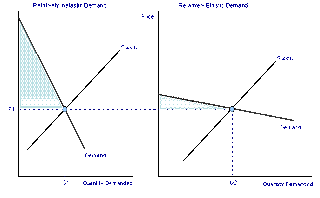- Long gestation period
- Perishable
- supply problems (supply is inelastic) (GOOD CROPS/BAD CROPS)
- demand is inelastic.
This three factors will affect the elasticity of the supply curve to be inelastic. Demand on agricultural goods are also inelastic because it's a necessity to the consumers.Therefore, agricultural goods tend to subject to large price fluctuations. A change in supply(poor crop) will cause a big change in price (increase) but a small change in quantity demanded. Due to a large increase in price, poor consumers are not able to afford. As i said before, the demand is inelastic. Which means agricultural goods has less substitutes and consumers are not able to switch to other alternatives. Therefore, government intervention must comes in in order to help the poor.
INTERVENTION
Using price as a control
There are 2 types
- minimum price
- maximum price
Minimum price is a price that's set above the equilibrium in order to help producers to earn, to make higher profits. We all know if we set prices above the equilibrium it'll create a surplus in the market. The price is too expensive which causes the demand to decrease and many goods will not be sold into the market. One way to solve the surplus, is that government can buy the surplus and use it for other purposes. Besides that, imposing quotas could also prevent surplus so that resources are not wasted. Lastly, producers can start advertising their products more but it may cost a lot as well. Although, setting minimum price might help the producers to earn more. However, goods are wasted if it's not utilized. Minimum is not really a good way to solve the problem.
Maximum price is a price that's set below the equilibrium in order to help consumers from being charged to high by the producers. We know that setting the price below the equilibrium will create a shortage in the market. The demand will be higher that the goods available. The poor may get the benefit from getting cheap goods but they might not satisfy the goods they want. Good such as food is a necessity for them and if this really happens, many people will be starved to death. Black market will happen as well, since goods are getting lesser in the market, the rich will buy up the goods with higher price in order to satisfy their wants. A way to solve this problem is to have subsidy from he government and this will help reduce shortage and meet a new equilibrium price in the market.
Buffer Stock Schemes
This a way to fix a particular price of a good. For example, the price for a pear cost Rm5 and the quantity demanded in 40. During bumper season, the supply for pears increase by 50. So now the quantity demanded on pear will be 90 and this will reduce the price of the pears to Rm4. In order to maintain the price at Rm5. The government will buy up the extra 50 pears and do something else with it. The number of pears will reduce back to 40 and the price will remain the same. (: The disadvantages of buffer stock schemes is that agricultural goods like pears does not have long shelf life and it take a lot of money to store them. Raising the price from 4 to 5 by imposing tax will also be a good idea to maintain price as well. Lastly, the government can use the excess supply to cover shortage problems as well.
Cartel
A cartel is a formal agreement among competing firms. It's a formal organization of producers and manufacturers that agree to fix prices, marketing, and productions.


.gif)

.jpg)
.jpg)




.jpg)
.jpg)
.jpg)


.jpg)


.jpg)
.jpg)




